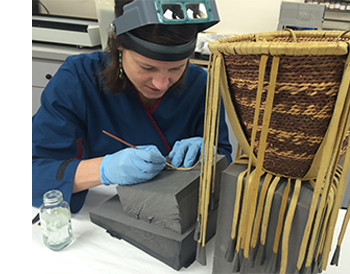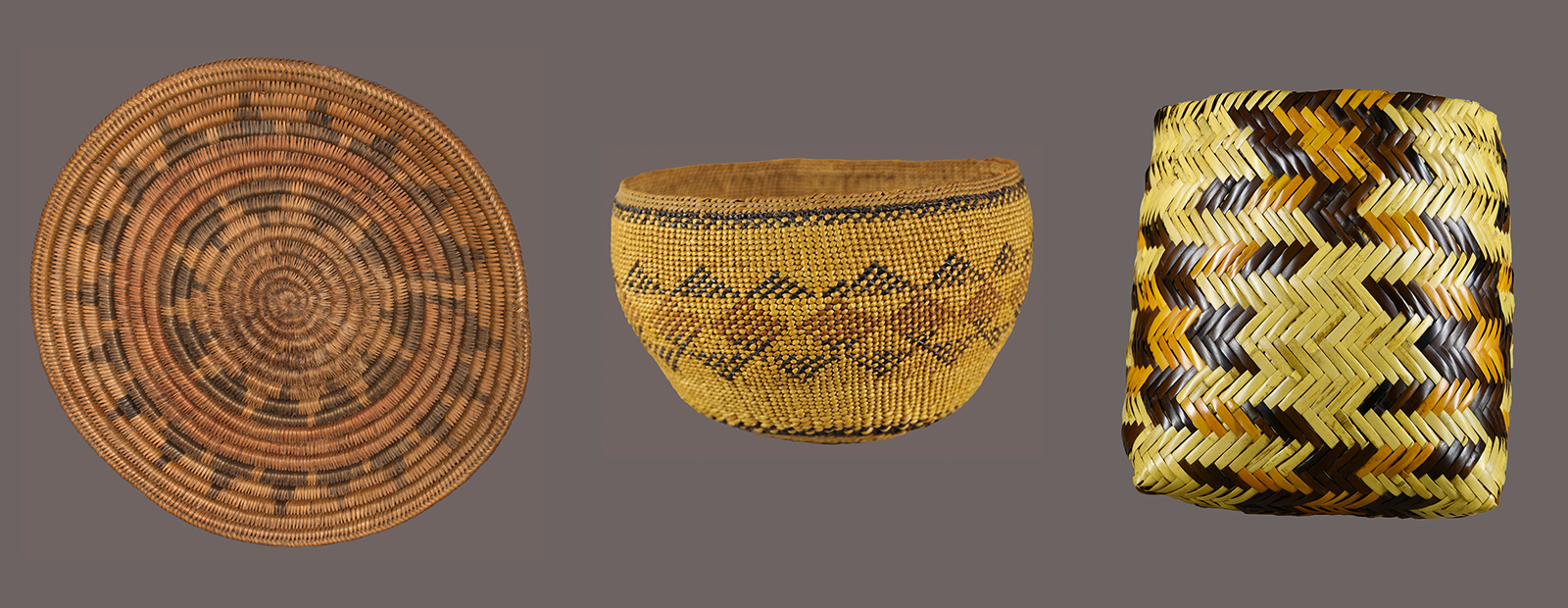Before the Carlos Museum closed in March due to COVID-19-related safety concerns, museum staff prepared and installed a number of baskets in the Native North Americas gallery as part of an annual rotation to limit light exposure for especially vulnerable objects.
 Mellon Advanced Fellow in Conservation Kaitlyn Wright completed the conservation work on many of them, including a Diné (Navajo) wedding basket. Reflecting on my own basket treatments for the 2016 exhibition Coiling Culture: Basketry Art in Native North America, I recall that one of my favorite aspects of the exhibition was that it featured examples from a number of local collectors.
Mellon Advanced Fellow in Conservation Kaitlyn Wright completed the conservation work on many of them, including a Diné (Navajo) wedding basket. Reflecting on my own basket treatments for the 2016 exhibition Coiling Culture: Basketry Art in Native North America, I recall that one of my favorite aspects of the exhibition was that it featured examples from a number of local collectors.
Serious collectors or not, many of us probably have basketry with meaningful histories in our homes. Whether Native North American, Colonial American, or personal objects, baskets from all cultures and time periods are typically comprised of plant materials that are coiled, twined or woven.
Everything from parts of stems and trunks to roots, leaves, and fibers from fruits and seeds can be worked into the structural or decorative elements of baskets. Examples of familiar basketry sources are willow, sumac, sweetgrass, juncus, and river cane, but materials range widely to include palms and even coconut fibers. Both synthetic and natural dyes can be used to color baskets. Examples of basketry are found throughout the Carlos Museum collections and can be seen in the galleries.
Baskets are intricate combinations of organic plant materials, making them vulnerable to a number of risks:
- Physical stresses from improper handling, use, display, and maintenance can alter the appearance of and damage the basket.
- Dust, grime, and residues from prior treatments or cleaning agents can dull and mask the surface as well as make the basketry materials brittle and accelerate deterioration.
- Light can discolor or fade plant materials and dyes and increase susceptibility to other forms of deterioration. Unfiltered sunlight poses the highest risk due to the high proportion of ultraviolet waves, but cumulative exposure to any light source is harmful.
- High temperatures, especially coupled with high humidity, can result in changes to gloss, texture, and color as well as reduce overall strength and resistance to abrasion.
- High humidity and moisture can cause swelling and shrinkage, resulting in cracking, splitting, and warping. Rapid swings in humidity lead to more extreme damage.
- Mold, mildew, and other fungal spores can disfigure the appearance of baskets, concealing surface decoration and causing stains. Fungi flourish in high humidity but generally remain inactive below 60% relative humidity.
- Pests of all sorts can nest in and leave debris on baskets. Cockroaches, moth larvae, beetles, silverfish, booklice, mice, and rats are attracted to basketry materials, surface soils, and contents.
Tips for Caring for Baskets
- Handle baskets with clean hands or nitrile gloves; if possible, avoid fabric gloves to reduce the chance of catching and abrading fibrous elements.
- If you choose to use baskets as containers for either decorative or storage purposes, ensure that the materials contained are not too heavy or large and will not stain or attract insects. Otherwise consider using a liner, such as light-weight plastic or something similar.
- Avoid mounting or hanging baskets in such a way as to place undue stress on one part (such as on a handle or one side). Also avoid placing heavy items on top of baskets in storage.
- Don’t attempt to repair or reinforce areas of weakness with tape, glue, or clips; contact a conservator for condition assessment and repair.
- Don’t attempt the application of wet solutions for cleaning baskets; contact a conservator for removal of inappropriate/undesirable stains or accretions.
- Remove dust with a very soft-bristled brush or duster, and avoid catching the brush or duster on split/damaged areas or separating protruded fibers. Dust can be gently brushed toward a vacuum nozzle, held several inches away from the surface of the basket. Do not use vacuum brush attachments.
- Keep out of direct sunlight, and periodically rotate baskets between display and storage.
- Store baskets in conditioned areas, and not in attics, garages, or basements, which tend to experience more extreme temperature and humidity. This will also deter mold, mildew, and fungal growth.
- Check routinely for signs of rodent or insect activity, including droppings, casings, nesting materials, or damaged areas.
Top, left to right:
"Wedding" Basket. Southwestern United States. Diné (Navajo). Late 19th-mid 20th century. Yucca, sumac, dye. Gift of Philip Gainey and Family.
Basket Bowl. United States, California. Yurok, Hupa, or Karuk. Early-mid 20th century. Willow or hazel, redwood or spruce root, bear grass, lichen, alder, giant fern, maidenhair fern. Gift of Philip Gainey and Family.
Rowena Bradley (Ani’yuni’ya, Eastern Band of Cherokee Indians, 1922-2003). Double-Weave Basket. Southeastern United States, North Carolina, Qualla Boundary. Ca. 1980. River cane, natural dyes. Gift from the Medford and Loraine Johnston Collection in memory of Sarah (Sally) Medford Johnston.
In body:
Small Burden Basket with Fringe. United States, Arizona or New Mexico. Indeh (Apache). Late 20th century. Willow or cottonwood, hide or chamois, tin: twined. Lent by Anne Sayre.





